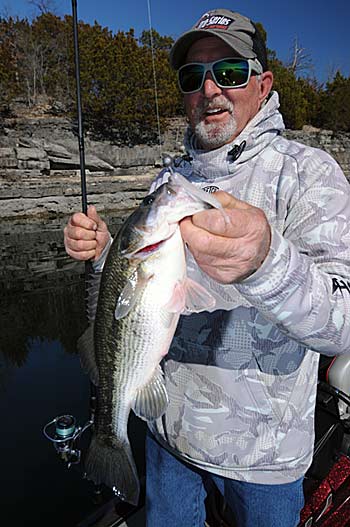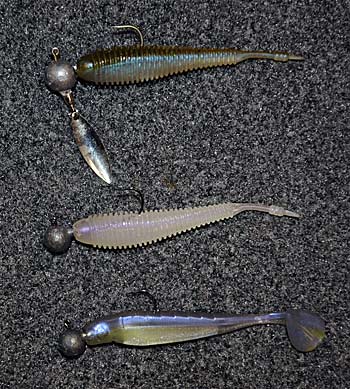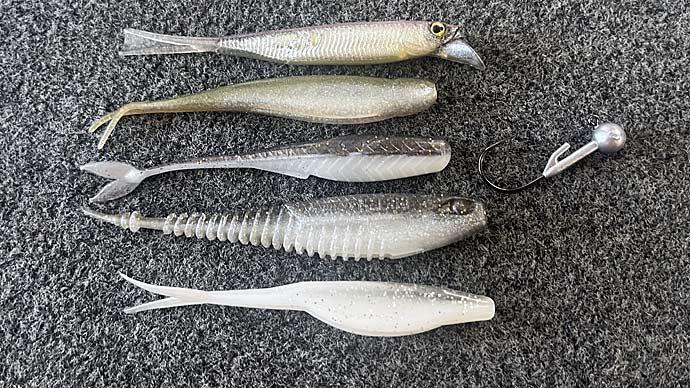
Bright sunshine, bluebird skies, and calm weather create a surface as slick as glass on a clear water lake.
While many bass anglers consider this a tough situation, Missouri guide Pete Wenners believes these conditions are ideal for a finesse technique that continues to gain popularity throughout the country.
When he faces these tough conditions on his home waters of Table Rock Lake, Wenners resorts to the Damiki rig named after the Damiki Armor Shad, the original small shad bait rigged on a jighead. Wenners recalls the rig is similar to a finesse technique he and other Table Rock Lake anglers used years ago fishing with a 4- or 5-inch single curly tail plastic grub with 1/4-ounce jigheads. "Any more with the Damiki rig stuff, we are fishing so deep with 3/8-, 1/2- and 5/8-ounce heads but still using the small baits,” Wenners says.
The guide relies more on a straight-tail finesse bait to attach to his jighead, which he thinks better imitates baitfish. "The swimbait and grub will still work, but the last four or five years, the deal seems to be straight tail baits almost like a miniature fluke or the Missile Baits Spunk Shad,” Wenners says. “Something with almost no action seems to work better than the swimbait with a lot of tail action."
Forward-facing sonar has made the Damiki rig an effective tactic for tricking bass in open water. “One thing about forward-facing sonar we have learned so much about is how much time these bass spend out in the middle of nowhere,” Wenners says. “You can also see how they react to different styles of baits.”
The Damiki rig is also effective when a slight breeze creates a little ripple on the water, but too much wind hampers this style of finesse fishing. “It doesn’t work well in real windy conditions because it is hard to present the bait to the bass,” Wenners says.
While mainly used as a clear-water technique, the Damiki rig has also produced well for Wenners in the dirtier water of the riverine sections of Table Rock Lake. Wenners opts for brighter colors such as white or chartreuse for his soft plastics when fishing dirtier water.
Wenners has discovered that the versatile Damiki rig can be fished horizontally or vertically at various depths. By changing the weight of his jigheads, Wenners can effectively fish the Damiki rig at depths ranging from 2 to 80 feet. The Missouri angler pours his jigheads, including some with a spinner attached to give his rig more flash. Pouring his jigheads allows Wenners to match the right size hook with his smaller soft plastics. "The problem in the past was I couldn’t get a heavy head with a small hook like a 2/0 hook," Wenners says. "I would find a 1/2- or 5/8-ounce head with a 3/0 or 4/0 hook which would stunt the bait. So you want a pretty small hook, so you still get some action from the backside of the bait.”
The Missile Baits Spunk Shad and the 5-inch Big Bite Baits Jerk Minnow are Wenners' favorite lures for his Damiki rig. He favors shad colors such as the Missile Baits Goby Bite (green/pearl), Bombshell (purple/chartreuse), and Frosted Purple for his soft plastics. The Baitfish hue of a Zoom Super Fluke Junior is another color Wenners prefers for his Damiki rig.

The Damiki rig originated as a vertical jigging technique, but Wenners noticed that fishing pressure has caused a change in presentations. "It seems like the fish are getting smarter, or we aren't as smart as we used to be because it seems like we have to stay back off them now," he says. “If the bass are really aggressive, you can vertical fish them, but for the most part, you have to be 40 to 80 feet away from them. That is where the forward-facing sonar is huge."
Locating baitfish with his Garmin electronics is the key to success for Wenners’ Damiki rig presentation. "Many times, I am looking for big schools of baitfish, and I am fishing it underneath the shad," he says. “So if the shad are down there 20 feet, I am going to try and get my bait down to 20 or 25 feet because many times those bass that want an easy meal are underneath those big balls of shad."
Wenners presents his Damiki rig on a 7-foot medium or medium-light spinning rod with a fast action tip and a 2000 Series spinning reel spooled with 12-pound Sunline Xplasma braided line. He ties an FG knot to connect a 12- to 15-foot leader of 8-pound Sunline Super FC Sniper fluorocarbon to his braid line.
When he finds a ball of shad, Wenners casts past the baitfish and lets the rig fall to the depth of the forage. He swims the rig into the bait ball and then lets it fall to imitate a dying shad dropping to the bass hovering below the bait.
Wenners uses a presentation similar to a shaky head retrieve as he is swimming and dropping it to the bass. “When you get the bait around the bass, you want to be shaking it," he says. “A lot of these (Damiki rig) baits don't have any tails on them, so shaking your rod tip makes the baits shimmy just a little bit.”
The Damiki rig has produced numbers of bass and quality fish up to six pounds for Wenners. He catches bass on the rig throughout most of the year, except when bass are shallow during the spawn. His favorite times to employ the rig are during the winter and the postspawn when bass school in deep water.
BassResource may receive a portion of revenues if you make a purchase using a link above.




